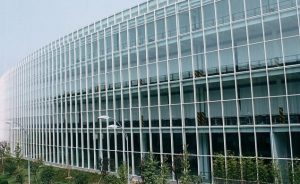What is Curtain Wall? its 2 Systems, Benefits, & Disadvantages
The curtain wall is thin and lightweight. Usually, aluminum and glass and these walls are not structural and can only carry their weight by design.
Curtain walls are one type of building skin separating interior from exterior environments and are also known as cladding or building facade. The Curtain-wall is used to ensure that the interior of the building remains airtight, and the design of this wall makes it air and water-resistant.

The curtain wall is a mostly aluminum-framed wall containing in-fills of metal panels, glass, or thin stone, and these walls do not carry the floor or roof loads of the structure.
To protect the building interior against natural exterior phenomena such as sun exposure, temperature changes, earthquake, rain, and wind curtain-wall system is used.
Curtain wall system maintenance and renovation have a very significant impact on the life-cycle cost of the building. However, if the durability of all curtain-wall functions can be determined, then this cost impact can only be evaluated.
Systems of Curtain Wall:
By method of fabrication and installation, curtain-wall can be classified into the following two general categories;
- Stick Curtain Wall System
- Unitized Curtain-wall system
Stick Curtain Wall System:
In the stick curtain-wall system, the walls are usually suspended in front of structural steel or concrete framing, and these walls are non-load bearing walls. These walling systems are versatile and allow for integrating other methods such as sliding windows and doors.
These walls can be built by all types of fabricators as they are not dependent on having a large factory, and they tend to be less specialized.

To erect and seal the wall, stick systems require multiple steps, and an approximate rule of thumb would be that 30% of the work is carried out in the factory and 70% of the work is carried out on-site, which means more time is spent on site.
Advantages of Stick Curtain Walling System:
There are the following advantages of curtain walling system such as;
- At very competitive prices and short lead-in time, wide availability of system choices on the market.
- For angular or complex facades, it is suitable.
- As compared to unitized curtain-walling, sightlines are slimmer in this system.
- The fast production process in the factory and the sequence of buildings can be changed quickly.
Unitized Curtain-wall system:
Before shipping to the building site for installation, a unitized curtain-wall system comprises large units that are pre-assembled and glazed in the factory. Thermal efficiency, sound transmission, and fire safety become the critical performance criteria of the unitized curtain-walling system.
To create a complete system, the vertical and horizontal modules mate and stack together, and as modules can be one story tall and five to six feet wide, cranes are most often used to install these systems.

With unitized curtain wall construction, two types of alignment conditions must be considered such as;
- Alignment between unitized panels.
- Alignment between projecting slabs and unitized panels and other offsetting structural features.
Advantages of Unitized Curtain Walling System:
There are the following advantages of a unitized curtain walling system such as;
- In this system, all the panels are pre-assembled before arrival on-site, so the speed of construction is fast.
- Due to the main assembly occurring in a carefully controlled factory environment, this system has higher quality and also easier to manage.
- For mid to tall rise buildings with large areas of curtain wall, unitized systems are typically reserved.
Features of Curtain Wall System:
Including the effects of thermal expansion and contraction, the sway and movement of a building, and thermal efficiency, curtain walls are helpful.
Inside, outside, or structurally these walls can be installed with several glazing options, and as a stick-framed wall that is split by mullions to create smaller panes, they can also be installed. Depending on the design requirements, you can choose the length of your lines and the depths of the million, and while allowing thermal movement, these walls provide lateral resistance.
You can create unique and visually stunning exteriors because they can be installed in any size and design.
Benefits of Curtain Wall:
These walls will prevent some of the heat and light from coming into the house and results in thermal efficiency and glare reduction, and this result will be more comfortable.

There are the following benefits of the curtain wall as given below;
- These walls can be used either to block light or allow light to penetrate deeper into the building.
- From the outside of the building, these walls provide additional sound insulation.
- In the building, these walls reduce water and moisture penetration.
- To the building facade, these walls provide a unique and more elegant look.
Disadvantages of Curtain Wall:
There are also some disadvantages such as;
- For completion, these walls require additional glass and steel, and against weather elements like rust, mineral deposits, and stains, these materials can become vulnerable.
- To keep their aesthetic value intact, they require regular maintenance.
- Because of the addition of a curtain wall, construction costs may also increase significantly.
- By unfavorable weather conditions, the installation of these structures may be delayed.
